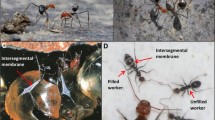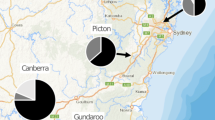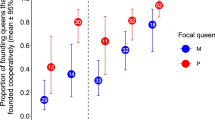Abstract
Establishment of new groups is an important step in the life history of a social species. Fissioning is a common mode not only in group proliferation, for instance, as a regular part of the life cycle in the honey bee, but also when multiple females reproduce in the same group, as in multiple-queen ant societies. We studied the genetic consequences of fissioning in the ant Proformica longiseta, based on DNA microsatellites. In P. longiseta, new nests arise by fissioning from the old ones when they grow large, and the daughter nests consist of workers and queens or queen pupae but never both. Our results show that fissioning is not entirely random with respect to kinship. Workers tend to segregate along kin lines, but only when the initial relatedness in the parental nests is low. Workers in a daughter nest also tend to be associated with closely related adult queens, whereas such an association is not detected between workers and queen pupae. Most queens and workers are carried to the daughter nest by a specialized group of transporting workers, suggesting active kin discrimination by them. Fissioning pattern in P. longiseta is different from that found in other social insects with regular fission (e.g., the honey bee, swarm-founding wasps), where no fissioning along kin lines has been found. It does, however, resemble fissioning in another group of social animals: primates.


Similar content being viewed by others
References
Arnold G, Quenet B, Masson C (2000) Influence of social environment on genetically based subfamily signature in the honeybee. J Chem Ecol 26:2321–2333
Avilés L (2000) Nomadic behaviour and colony fission in a cooperative spider: life history evolution at the level of the colony? Biol J Linn Soc 70:325–339
Boomsma JJ, Nielsen J, Sundström L, Oldham NJ, Tentschert J, Petersen HC, Morgan ED (2003) Informational constraints on optimal sex allocation in ants. Proc Natl Acad Sci U S A 100:8799–8804
Bourke AFG, Franks NR (1995) Social evolution in ants. Princeton University Press, Princeton
Breed MD, Welch CR, Cruz R (1994) Kin discrimination within honey bee (Apis mellifera) colonies: an analysis of the evidence. Behav Processes 33:25–40
Brown WD, Keller L (2002) Queen recruitment and split sex ratios in polygynous colonies of the ant Formica exsecta. Ecol Lett 5:102–109
Carlin NF, Frumhoff PC (1990) Nepotism in the honey bee. Nature 346:706–707
Chagnon NA (1975) Genealogy, solidarity, and relatedness: limits to local group size and patterns of fissioning in an expanding population. Yearb Phys Anthropol 19:95–110
Chapuisat M (1996) Characterization of microsatellite loci in Formica lugubris B and their variability on other ant species. Mol Ecol 5:599–601
Chepko-Sade DB, Olivier TJ (1979) Coefficient of genetic relationship and the probability of intergenealogical fission in Macaca mulatta. Behav Ecol Sociobiol 5:263–278
Chepko-Sade DB, Sade DS (1979) Patterns of group splitting within matrilineal kinship groups. Behav Ecol Sociobiol 5:67–86
Crozier RH, Pamilo P (1996) Evolution of social insect colonies. Oxford University Press, Oxford
Dani FR, Foster KR, Zacchi F, Seppä P, Massolo A, Carelli A, Arévalo E, Queller DC, Strassmann JE, Turillazzi S (2004) Can cuticular lipids provide sufficient information for within-colony nepotism in wasps? Proc R Soc London B 271:745–753
Dittus WPJ (1988) Group fission among wild toque macaques as a consequence of female resource competition and environmental stress. Anim Behav 36:1626–1645
Elmes GW (1987) Temporal variation in colony populations of the ant Myrmica sulcinodis I. Changes in queen number, workers number and spring production. J Anim Ecol 42:761–771
Estoup A, Solignac M, Cornuet JM (1994) Precise assessment of the number of patrilines and of genetic relatedness in honeybee colonies. Proc R Soc London B 258:1–7
Fernández-Escudero I, Tinaut A (1999) Factors determining nest distribution in a high-mountain ant. Ethol Ecol Evol 11:325–338
Fernández-Escudero I, Seppä P, Pamilo P (2001) Dependent nest founding in the ant Proformica longiseta. Ins Soc 48:80–82
Fernández-Escudero I, Pamilo P, Seppä P (2002) Biased sperm use by polyandrous queens of the ant Proformica longiseta. Behav Ecol Sociobiol 51:207–213
Franks NR, Fletcher CR (1983) Special patterns in army ant foraging and migration: Eciton burchelli on Barro Colorado Island, Panama. Behav Ecol Sociobiol 12:261–270
Frumhoff PC (1991) The effects of the cordovan marker on apparent kin discrimination among nestmate honey bees. Anim Behav 42:854–856
Gamboa GJ (1996) Kin recognition in social wasps. In: Turillazzi S, West-Eberhard MJ (eds) Natural history and evolution of paper wasps. Oxford University Press, Oxford, pp 161–177
Gamboa GJ (2004) Kin recognition in eusocial wasps. Ann Zool Fennici 41:789–808
Getz WM, Bruckner D, Parisian TR (1982) Kin structure and swarming behavior of the honey bee. Behav Ecol Sociobiol 10:265–270
Goodnight KF (1994) Relatedness. Goodnight Software, Houston
Grafen A (1990) Do animals really recognize kin? Anim Behav 39:42–54
Greenberg L (1979) Genetic component of bee odor in kin recognition. Science 206:1095–1097
Greenwood PJ (1980) Mating systems, philopatry and dispersal in birds and mammals. Anim Behav 28:1140–1162
Gyllenstrand N, Gertsch PJ, Pamilo P (2002) Polymorphic microsatellite DNA markers in the ant Formica exsecta. Mol Ecol Notes 2:67–69
Hamilton WD (1964) The genetical evolution of social behaviour. J Theor Biol 7:1–16
Heinze J, Elsishans C, Hölldobler B (1997) No evidence for kin assortment during colony propagation in a polygynous ant. Naturwissenschaften 84:249–250
Hölldobler B, Wilson EO (1990) The ants. Belknap Press of Harvard University Press, Cambridge MA, USA
Hughes CR, Queller DC, Strassmann JE, Gastreich KR, Solís CR, Negrón-Sotomayor J (1993) The maintenance of high genetic relatedness in multi-queen colonies of social wasps. In: Keller L, Cherix D (eds) Queen number and sociality in insects. Oxford University Press, Oxford, pp 153–170
Jeanne RL (1980) Evolution of social behavior in the Vespidae. Ann Rev Entomol 25:371–396
Jeanne RL (1991) The swarm-founding Polistinae. In: Ross KG, Matthews RW (eds) The social biology of wasps. Cornell University Press, Ithaca, pp 191–231
Keller L (1997) Indiscriminate altruism: unduly nice parents and siblings. Trends Ecol Evol 12:99–103
Keller L, Passera L, Suzzoni J-P (1989) Queen execution in the Argentine ant Iridomyrmex humilis (Mayr). Physiol Entomol 14:157–163
Kelly JK (1994) The effect of scale dependent processes on kin selection: mating and density regulation. Theor Pop Biol 46:410–420
Kryger P, Moritz FA (1997) Lack of kin recognition in swarming honeybees (Apis mellifera). Behav Ecol Sociobiol 40:271–276
Kuester J, Paul A (1997) Group fission in Barbary Macaques (Macaca sylvanus) at Affenberg Salem. Int J Primatology 18:941–966
Lefebvre D, Ménard N, Pierre JS (2003) Modelling the influence of demographic parameters on group structure in social species with dispersal asymmetry and group fission. Behav Ecol Sociobiol 53:402–410
Lorenzi MC, Bagnères A-G, Clément J-L (1996) The role of cuticular hydrocarbons in social insects: is it the same in paper wasps? In: Turillazzi S, West-Eberhard MJ (eds) Natural history and evolution of paper wasps. Oxford University Press, Oxford, pp 178–189
Ménard H, Vallet D (1993) Dynamics of fission in a wild Barbary Macaque group (Macaca sylvanus). Int J Primatology 14:479–500
Michener CD (1974) The social behavior of the bees: a comparative study. Harvard University Press, Cambridge, MA, USA
Möglich M (1978) Social organization of nest emigration in Leptothorax (Hym., Form.). Ins Soc 25:205–225
Moritz RFA (1991) Kin discrimination in honeybees: experimental artifact or biological reality? In: Goodman LJ, Fisher RC (eds) The behaviour and physiology of bees. CAB International, Wallingford, pp 48–59
Moritz RFA, Southwick EE (1990) Bees as superorganisms. An evolutionary reality. Springer, Berlin
Nash LT (1976) Troop fission in free-ranging baboons in the Gombe Stream National Park, Tanzania. Am J Phys Anthropol 44:63–78
Oi T (1988) Sociological study on the troop fission of wild Japanese monkeys (Macaca fuscata jakui) on Yakushima island. Primates 29:1–19
Okamoto K, Matsumura S (2001) Group fission in moor macaques (Macaca maurus). Int J Primatology 22:481–493
Oldroyd BP, Rinderer TE, Buco SM (1990) Nepotism in the honey bee. Nature 346:707–708
Page RE, Robinson GE, Fondrk MK (1989) Genetic specialists, kin recognition and nepotism in honeybee colonies. Nature 338:576–579
Queller DC (1994) A method for detecting discrimination within natural colonies of social insects. Anim Behav 47:569–576
Queller DC, Goodnight KG (1989) Estimating relatedness using genetic markers. Evolution 43:258–275
Ratnieks FLR, Reeve HK (1992) Conflicts in single-queen hymenopteran societies: the structure of conflict and processes that reduce conflict in advanced eusocial species. J Theor Biol 158:33–65
Reeve HK (1989) The evolution of conspecific acceptance thresholds. Am Nat 133:407–435
Rosengren R, Pamilo P (1983) The evolution of polygyny and polydomy in moundbuilding Formica ants. Acta Entom Fenn 42:65–77
Schneirla TC (1971) Army ants: a study in social organization. Freeman, San Francisco, CA, USA
Seeley TD (1985) Honeybee ecology: a study of adaptation in social life. Princeton University Press, Princeton, NJ, USA
Seppä P, Fernández-Escudero I, Gyllenstrand N, Pamilo P (2006) Obligatory female philopatry affects genetic population structure in the ant Proformica longiseta. Ins Soc 53:362–368
Silk JB (2002) Kin selection in primate groups. Int J Primatology 23:849–875
Solís CR, Hughes CR, Klingler CJ, Strassmann JE, Queller DC (1998) Lack of kin discrimination during wasp colony fission. Behav Ecol 9:172–176
Sundström L (1994) Sex ratio bias, relatedness asymmetry and queen mating frequency in ants. Nature 367:266–268
Wade MJ (1985) Hard selection, soft selection, kin selection, and group selection. Am Nat 125:61–73
Widdig A, Nürnberg P, Bercovitch FB, Trefilov A, Berard B, Kessler MJ, Schmidtke J, Streich WJ, Krawczak M (2006) Consequences of group fission for the patterns of relatedness among rhesus macaques. Mol Ecol 15:3825–3832
Wilson DS (1975) A theory of group selection. Proc Natl Acad Sci USA 72:143–146
Winston M (1987) The biology of the honey bee. Harvard University Press, Cambridge, MA, USA
Acknowledgements
We thank Pia Gertsch for help in the lab, Cathy Liautard for discussions, and anonymous referees for insightful comments. This work was supported by a Marie Curie fellowship (EU-TMR, to I F-E), Swedish Natural Research Council of Science and EU-TMR network “Social Insects” (to PP). The work described in this article comply with the current laws of the countries in which it was performed.
Author information
Authors and Affiliations
Corresponding author
Additional information
Communicated by K. Ross
Rights and permissions
About this article
Cite this article
Seppä, P., Fernández-Escudero, I., Gyllenstrand, N. et al. Colony fission affects kinship in a social insect. Behav Ecol Sociobiol 62, 589–597 (2008). https://doi.org/10.1007/s00265-007-0483-2
Received:
Revised:
Accepted:
Published:
Issue Date:
DOI: https://doi.org/10.1007/s00265-007-0483-2




